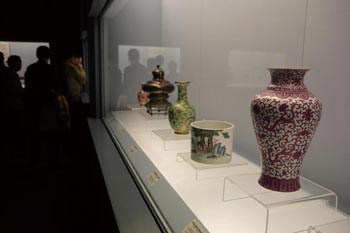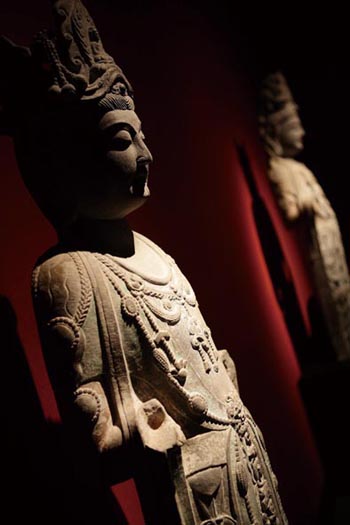Written by: Luo Zhewen
Posted on: January 16, 2013 |  | 中文
| 中文
The scope, depth and quality of its collections, and the striking architecture and use of modern technology make the Shanghai Museum one of the most famous - if not the most famous - museums in China. It covers an area of 39,000 square meters, with a scale that surpasses that of the old museum several times. The exterior of the museum is in the shape of an ancient bronze ding with its rather archaic flavor. The structure and materials of the entire building, however, are an accomplishment of the most modern technology.
 The Shanghai Museum is mainly a museum for ancient arts. At present it is divided into ten sections. These are constituted by ancient Chinese bronzes, sculpture, ceramics, jades, seals, calligraphy, coin and currency, paintings, Ming and Qing dynasty furniture, and crafts of China's national minorities. In addition to these ten permanent exhibitions, the museum holds other small-scale exhibitions, also exhibiting articles from other area of China and the other countries on a short-term basis. The Museum also exhibits its own material in other museums, both within China and abroad.
The Shanghai Museum is mainly a museum for ancient arts. At present it is divided into ten sections. These are constituted by ancient Chinese bronzes, sculpture, ceramics, jades, seals, calligraphy, coin and currency, paintings, Ming and Qing dynasty furniture, and crafts of China's national minorities. In addition to these ten permanent exhibitions, the museum holds other small-scale exhibitions, also exhibiting articles from other area of China and the other countries on a short-term basis. The Museum also exhibits its own material in other museums, both within China and abroad.
Among the holdings of the Museum, many items are superlative works of art and are unique in the entire country. These include, in particular, the bronzes, the calligraphy, the paintings, and the Ming and Qing furniture.
 The bronze works of the dynasties of Shang and Zhou of ancient China are an important testimony to the ancient civilization of the country. When visitors enter the Ancient Bronzes Hall, the presentation and atmosphere of the rooms expresses the cultural ambience of the Bronze Age. The subdued dark-green tone of the walls imparts an ancient atmosphere, with the simple and elegant display cases and the lighting having been carefully designed to enhance the experience. Some 400 exquisite bronze items are displayed in a space of 1,200 square meters, perfectly reflecting the history of the development of China's ancient bronze arts.
The bronze works of the dynasties of Shang and Zhou of ancient China are an important testimony to the ancient civilization of the country. When visitors enter the Ancient Bronzes Hall, the presentation and atmosphere of the rooms expresses the cultural ambience of the Bronze Age. The subdued dark-green tone of the walls imparts an ancient atmosphere, with the simple and elegant display cases and the lighting having been carefully designed to enhance the experience. Some 400 exquisite bronze items are displayed in a space of 1,200 square meters, perfectly reflecting the history of the development of China's ancient bronze arts.
The Calligraphy Hall includes works from many dynasties. In chronological order, it displays the history of the marvelous genius of Chinese calligraphic arts. The aura of the hall is scholarly and elegant, assisted by automatic lighting in display cases that protects the art by switching on only when the visitor is viewing a work. Among these works are a number of unique world treasures.
The Chinese Painting Hall of the Museum has a traditional architectural style to it, combined with an atmosphere of Confucian elegance. Around 120 masterpieces are displayed in the 1,200 square meter exhibition space. These date from the Tang dynasty to modern times but do not include contemporary works.
The apex of Chinese furniture-making occurred during the Ming and Qing dynasties. Walking into the Ming and Qing Furniture Hall is like walking back into the gardens and rooms of these dynasties. In some 700 square meters of space are exhibited about 100 pieces of superlative furniture. Among these are Ming pieces that are fluid in line and harmonious in proportion. The Qing pieces have more complex ornamentation and are often made of thicker, heavier wood.
The underground part of the Shanghai Museum contains courtyard gardens that imitate authentic Chinese traditions. Although these are hidden deeply underground, their architecture and environment seem light and airy.
You may also like: